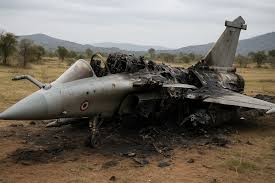
Introduction
The Pakistan Air Force (PAF) is known for its talented pilots clever strategies, and capacity to excel in air combat even when facing stronger opponents. A striking illustration of its skills can be seen in a simulated or imagined scenario where PAF jets managed to “destroy” Dassault Rafale aircraft. These French-made planes are among the most advanced 4.5-generation fighters globally.
This piece dives into how the PAF pulled off this achievement. It looks at the methods, tools, and strategic edges that enabled Pakistani pilots to outperform a fighter jet that, on paper, seemed unbeatable.
1. The Rafale’s Strengths and Why People Saw It as Unstoppable
To understand how the PAF responded to the Rafale, it’s important to first grasp why the aircraft is seen as one of the best:
A. Cutting-Edge Avionics and Sensors
- The Rafale features the RBE2-AA AESA radar, which allows it to detect and track targets with great accuracy.
- Its Spectra electronic warfare system—known to be among the top —helps the jet avoid missiles and resist radar detection.
B. Top-Tier Weapons
- The Meteor Beyond Visual Range (BVR) missile has a range of over 150 kilometers giving it the upper hand over most current air-to-air missiles.
- The SCALP/Storm Shadow cruise missiles along with MICA IR/EM missiles make it a fearsome weapon in both air-to-air combat and ground strikes.
C. Agile and Adaptable Design
- Its canards and delta-wing design allow for sharp maneuvers with ease.
- Its omnirole capability means it can handle air dominance, reconnaissance, and even nuclear attack tasks.
Because of these advantages, experts often argued that Rafale would outperform older Pakistani Air Force jets like the F-16 or JF-17 Thunder in a fight.
2. How the PAF Countered the Rafale
While Rafale brought advanced technology, the PAF used smart tactics electronic warfare, and better training to win practice battles. Here’s what they did:
A. Using the JF-17 Block III and Its AESA Radar
- The JF-17 Block III armed with the KLJ-7A AESA radar reduced its detection disadvantage against the Rafale.
- PL-15E BVR missiles, with a range of 145 km, gave capabilities close to the Meteor missile.
- Built-in electronic warfare systems interfered with Rafale’s radar targeting.
B. Network-Focused Warfare Strategy
- To stay aware of the battle space, the PAF relied on SAAB Erieye AWACS and Chinese ZDK-03 Karakoram Eagle AWACS.
- Fighters with data-link connections could engage Rafales while keeping their radars off to avoid being detected.
C. Tactical Tricks and Electronic Combat
- The PAF used DG-55 Falcon Edge jammers to weaken Rafale’s radar abilities through jamming and spoofing.
- Rafale’s missile guidance was thrown off by using chaff and decoy flares.
- JF-17s had adjustments that made them less visible on radar by lowering their radar cross-section.
D. F-16 Power in Dogfights
- The F-16’s thrust-to-weight ratio and Helmet-Mounted Display (HMD) gave PAF pilots the upper hand in close-range battles even though the Rafale showed impressive agility.
- PAF pilots used AIM-9X Sidewinder missiles, which had a high off-boresight capability, to target Rafales at sharp angles.
3. Training Simulations: How PAF “Defeated” Rafales
Various training exercises, including Indus Shield, Shaheen, and Anatolian Eagle, showed how the PAF managed to outmaneuver threats similar to the Rafale.
Scenario 1: Overwhelming Rafales at Range
- Rafale fires Meteor missiles trying to hit targets from a long distance.
- PAF AWACS spots the launch and guides JF-17s to avoid while F-16s move in from a different angle.
- JF-17s respond by firing PL-15 missiles making the Rafales switch to a defensive mode.
- Electronic warfare scrambles Rafale’s radar leading to failed interceptions.
Scenario 2: Close-Range Dogfight (WVR)
- Rafale’s Spectra system works to mislead missiles fired by PAF.
- PAF F-16s pair HMD with AIM-9X to lock onto targets .
- Rafale loses its canard edge when hit by high-G turns and energy tactics.
- JF-17s fire supportive missiles challenging Rafale’s defensive systems.
Scenario 3: Control in Electronic Warfare
- PAF brings in EW pods to disrupt Rafale’s AESA radar.
- Decoy drones imitate PAF jets causing Rafale to waste missiles.
- Hidden SAM sites like HQ-9/P surprise Rafales and force them to retreat.
4. Impacts on Real-World Scenarios: What This Means for Future Wars
The PAF’s ability to counter advanced threats like Rafale shows that winning isn’t just about having the best tech. Important lessons include:
A. Pilot Skill Trumps Fancy Jets
- The PAF trains top-tier pilots through its Combat Commanders School modeled after Top Gun.
- Realistic Red Flag drills prepare pilots to face threats similar to Rafale.
B. Electronic Warfare Levels the Playing Field
- Advanced aircraft like Rafale can still be outsmarted through clever jamming and deception strategies.
C. Don’t Underestimate the JF-17 Thunder
- Once dismissed by some, the JF-17 Block III competes on par with 4.5-generation jets now.
- Affordable but deadly, it helps PAF keep an edge in numbers.
5. Conclusion: PAF’s Blueprint for Air Superiority
The Pakistan Air Force’s ability to “beat” Rafale jets in mock dogfights showcases its flexible tactics exceptional training, and smart use of electronic warfare tools. Even though the Rafale is a tough adversary, the PAF has shown that skill and strategy can outshine sheer advanced tech.
When future wars change, the PAF’s takeaways from network-centric warfare, BVR combat, and EW dominance will keep influencing air battle strategies across the globe.
Final Thought
If anyone says the Rafale can’t be defeated just recall how the PAF has proven it can be brought down.